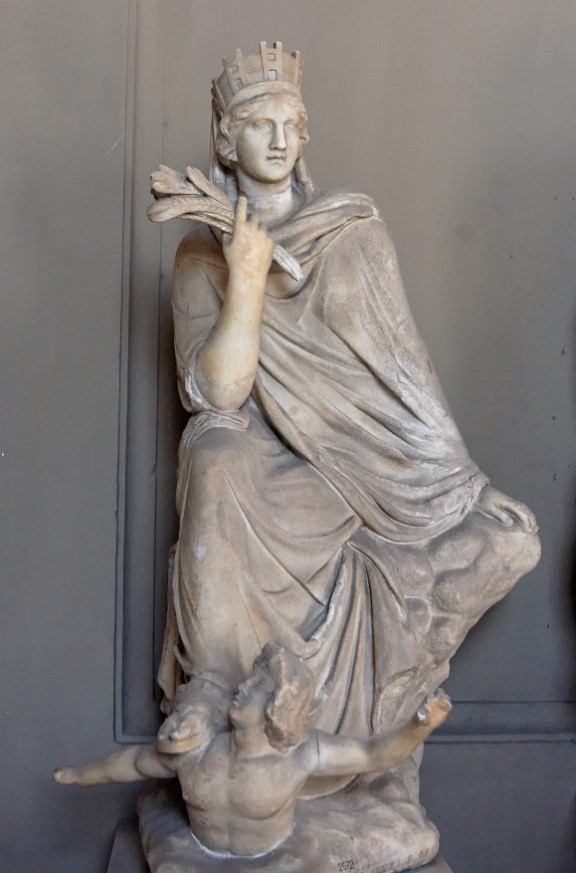The Significance of Water-Deities Subjugated by Tyche on the City-Coins of Syria-Palaestina and Arabia during the 2nd and 3rd century CE
Abstract:
The article proposes that the cities of the Southern Levant,
which minted coins in the second and third centuries CE,
depicting Tyche subjugating a water-deity had constructed
significant water supply systems. Proud of such achievements,
civic leaders were honoring Tyche who supplied their basic needs
by providing plentiful water.
Key Words:
Decapolis (https://d-nb.info/gnd/4222766-5),
coin iconography, Roman provincial coinage, Syria-Palestine (https://d-nb.info/gnd/4106469-0),
water management.
Zusammenfassung:
Im folgenden Artikel wird die These aufgestellt, dass die Städte
in der südlichen Levante, die im zweiten und dritten Jahrhundert
n. Chr. Münzen prägten, auf denen Tyche mit einer Wassergottheit
zu ihren Füßen abgebildet ist, bedeutende
Wasserversorgungssysteme errichtet hatten. Im Stolz auf diese
technischen Errungenschaften ehrten die städtischen Honoratioren
ihre Tyche, die durch die Bereitstellung von reichlich Wasser
ihre Grundbedürfnisse deckte.
Cities in Rome’s
Southern Levantine provinces proclaimed their identity on their
coins. They began to mint their own bronze coins following
Pompey’s subjugation of the region, expanded in number to their
apogee in the prosperous period of the Antonine and Severan
emperors, contracted with the economic tumult brought on by the
civil conflicts of the Barracks emperors and then ceased minting
coins before the reign of Diocletian. Generally, their coins
show the emperor or a member of the Imperial family on the
obverse and the reverse highlights a local theme that civic
leaders wanted to highlight[1].
Thus, the coins served as a means of expressing both loyalty to
Imperial Rome and local urban pride. The images and iconography
on the reverse of the city coins provide potential insights into
the products, history, religious beliefs, and the possible
presence of monumental structures associated with the cities[2].
Tyche on Coins
One deity particularly
favored on second and third century civic coins of the southern
Levant was the Greek goddess Tyche. She is easily identified by
her distinctive murate crown of salient towers and
recessed city walls. Tyche was the Greek goddess of fortune, and
a tutelary deity of cities. Her distinctive crown identified her
as a spiritual defender of the city who stood alongside the
physical defensive walls and citadels providing security. Tyche
is also frequently depicted holding a cornucopia. This
›horn of plenty‹ showed that the city honored her for the
blessings of the agricultural productivity and mercantile
success for which the local hard-working farmers and
craft-workers sweat[3].
Cities honored Tyche on their coins as an expression of
gratitude for gifts received, in the hope that she would bring
continued prosperity and additional blessings to the city[4].
The power of Tyche to direct the fortune of a city is also
indicated by the occasional depictions of her holding a ship’s
steering oar [gubernaculum] or standing on a prow
directing the movements of the ›ship of the city‹, even though
some coin-minting cities in the southern Levant using the image
were land-locked (see Map 1)[5].
Many cities developed
their own Tychai by combining iconic features such as
attire and weapons typical of other female figures from Greek
mythology, such as Amazons, Artemis[6],
and Athena[7]
or regional female Semitic deities such as Arstarte, Atargatis,
or Gad[8].
During the early years of minting urban coins in the southern
Levantine provinces, Tyche’s prominent status is particularly
indicated when she appeared on the obverse of coins[9].
By the third century CE, Tyche was widely featured showing her
head and shoulders but she is relegated to the reverse of coins[10].
During that same period she is most commonly depicted in full
body, either sitting or standing. There are numerous other
details such as Tyche holding various small, difficult to
discern symbolic objects in her hand. These aforementioned
observations of iconographic details and potential messages
raises a question of the significance of water-deities, not
always recognized on coins, since they variously have
half-bodies and lower bodies that taper off, but are clearly
depicted, at Tyche’s feet.
This article examines
the sub-type of Tyche standing or sitting coins that include a
water-deity at or beneath her feet. This image was likely
inspired by the famous third century BCE Hellenistic artist,
Eutychides of Sicyon’s, bronze image of Tyche of Antioch[11].
That masterpiece is preserved, at a large scale in a Roman
marble copy (Fig. 1). In that image, Tyche sits on a rock
with a water-deity beneath her feet. The swimming or struggling
young male figure is widely interpreted to be a depiction of the
River Orontes. The metropolis of Antioch, portrayed by her
crowned Tyche, is literally ›on the Orontes‹ even as the city’s
coin inscriptions proclaim[12].
The Greeks recognized
the existence of water-deities and presented them on their
pre-Roman coinage. They depicted water-deities in four main
ways: (1) As the head of man with long hair and beard; (2) as a
man-headed bull, or the forepart of a man-headed bull; (3) as a
figure swimming in water; (4) as a figure reclining in water or
resting on a water urn. By the first-century CE, Romans adopted
the earlier Greek practice of engraving water-deities onto coins
of cities built alongside waterways. The use of water-deity
images spread in the coinage of provincial cities in the
first-century BCE and continued in civic coins from the second
and third centuries CE in the Southern Levant[13].
The interaction between
Tyche and the various water-deities on the southern Levantine
coins appears to vary with the age and stature of the
water-deities. While Tyche is portrayed amicably standing or
sitting alongside an equal-size older generation long-bearded
male river deity like Hieromices (the River Hieromax/Yarmuk) on
coins of Adra’a[14],
she is very frequently portrayed as rudely stepping on what may
be inferior, lesser river’s deities that have short beards (Potameides),
perhaps female or beardless juvenile streams (Nymphs) and
legless/half-bodied springs (Pegaeae).
Tyche was a powerful, older generation member of the
Oceanid family of deities according to Hesiod[15].
It is not surprising that people in the Hellenized Levantine
provinces of Rome believed she could exert control over junior
members of her family.
The iconic ›Tyche of Antioch‹ that originally adorned a
public monument, in the Seleucid capital was embraced in the
later Roman provinces of Syria-Palestine and Arabia[16].
That appropriation could be attributed to an effort by those
cities of the second and third centuries to identify with
historically hallowed Hellenistic traditions. Our proposal is
that the subjugation of a water-deity by the patron goddess
Tyche is more specifically a local numismatic expression of the
city having secured significant water sources. As such, the
water-deity dominated by urban Tyche had a specific iconographic
denotation and was more than a regional historical connotation
suggesting that they had a Seleucid heritage[17].
Many of the cities minting coins of the sub-type, in focus here,
did have Seleucid connections but others did not. Cities using
the dominant Tyche coin-type, like Capitolias, remained to be
founded long after the fall of the Seleucid Empire during the
period of Roman rule. Other cities using the image, like
Philadelphia, were founded by the Ptolemies of Egypt. The
coin-minting cities that used the image of their Tyche
triumphant over water-deities are not all extensively excavated.
Most all of them, however, preserve artifacts of large scale
hydraulic supply systems with architectural remains such as
canals, tunnels, bridges, siphons and piping that carried fresh
water from water sources to monumental public water
installations such as fountains/nymphaea, thermae,
and major cisterns. The symbolic imagery on the reverse of a
polis’ coins communicated a message about the
cities’ possession of a substantial water supply and the
presence of water-associated amenities.
Evidence from the
City Coins
In the second and third
centuries CE, in the Roman provinces of Arabia and
Syria-Palaestina, there are two common depictions of Tyche
interacting with a water-deity. The first and most common
depiction is Tyche standing with her foot placed over a
water-deity. This is a dynamic pose of active subjugation. This
image was favored by the Transjordan cities, with ten cities
minting such imagery on their coinage at some point[18].
Of the available specimens of such coins, Bostra was the first
city in the Transjordan to utilize this image[19].
That coin has the bust of empress Faustina I (c. 140 CE) on the
obverse, with Tyche and a crouching water-deity on the reverse (fig.
2). In contrast, there are only three Cisjordanian cities
that utilize the image of Tyche standing with a foot suppressing
a water-deity[20].
The earliest specimen in the Cisjordan comes from the city of
Nysa-Scythopolis sometime during the later lifetime of Faustina
II (c. 163 CE)[21].
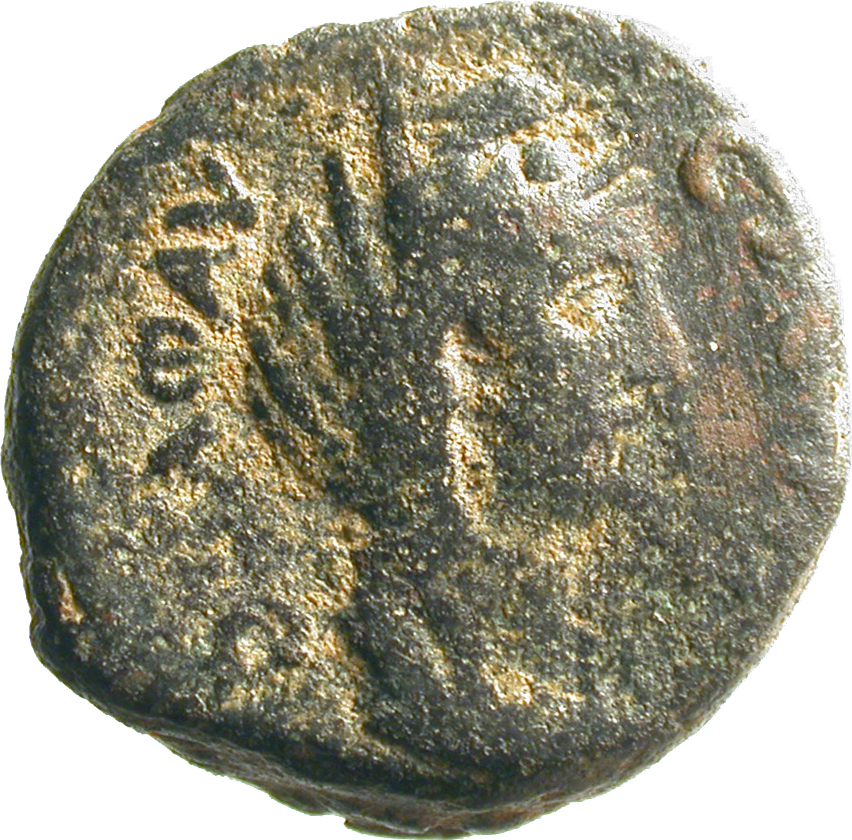
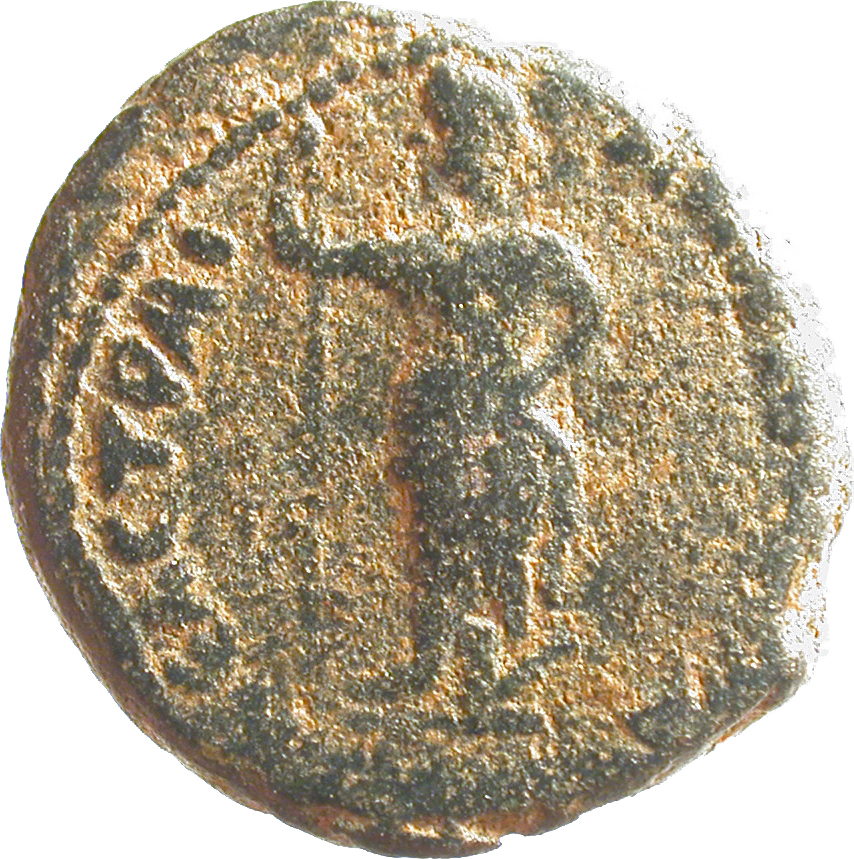
The second, less active depiction of Tyche’s triumph over water sources is with her sitting on a rock or dias, with her foot placed on a water-deity she has previously defeated (fig. 3). This image is also favored by the Transjordan cities, with five out of six occurrences in the assemblages of coin-minting cities east of the Jordan River[22]. A total of nineteen different Arabian and Syria-Palaestina cities used the two images of Tyche subjugating a water-deity (Map 2).
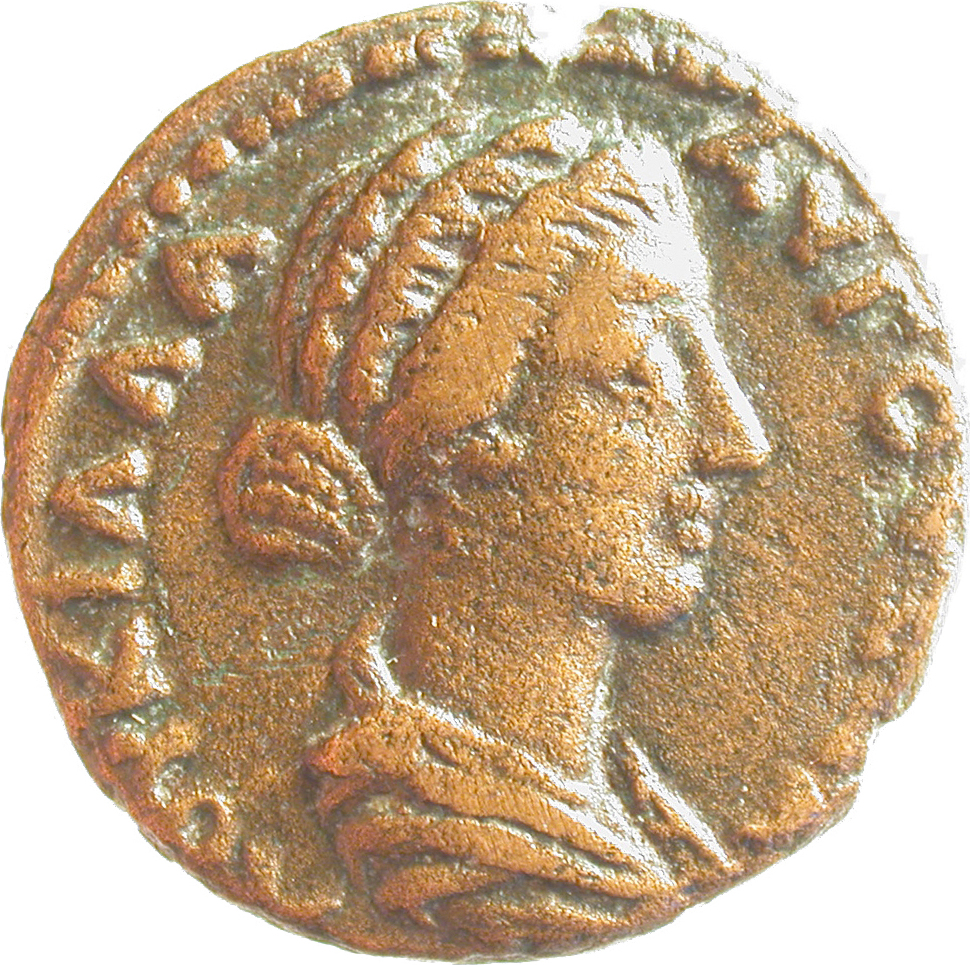
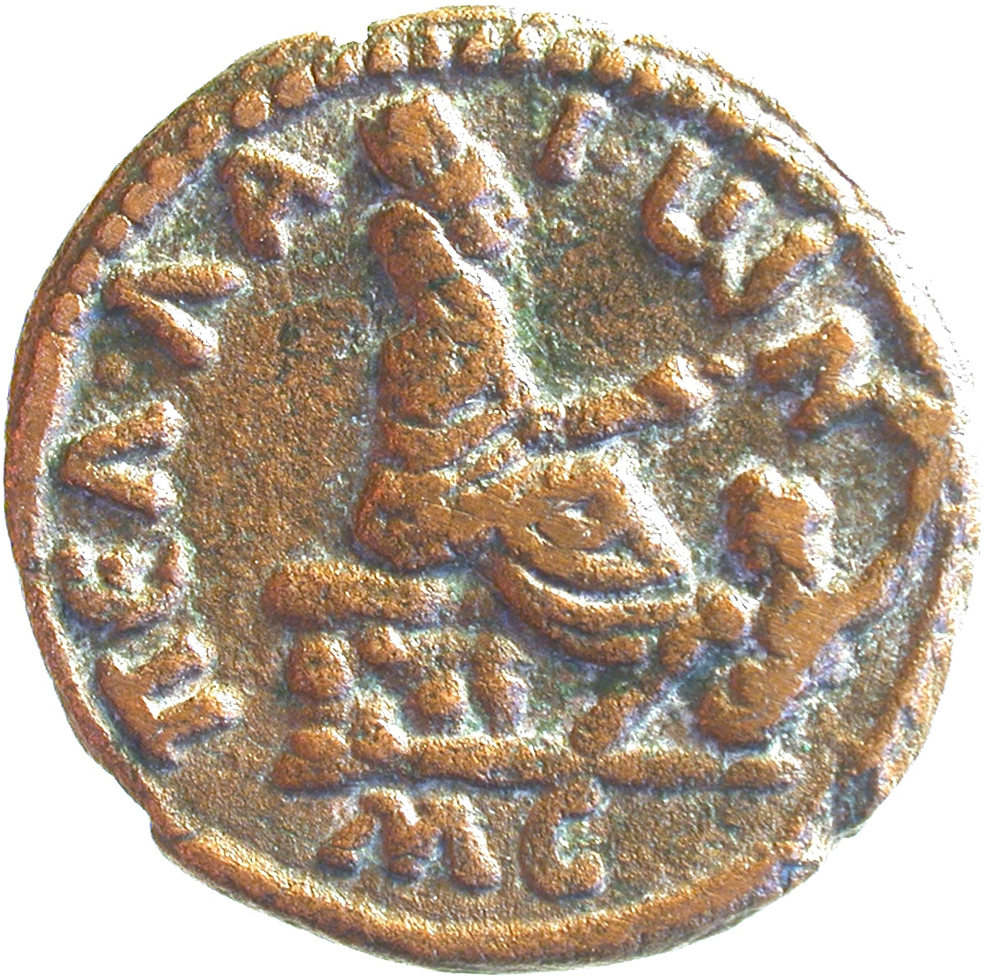
Depictions of Tyche standing upon water-deities or seated
using them as a footstool are both a symbolic portrayal of
Tyche’s triumph. The subjugation of a water-deity beneath a foot
suggests a less than amicable relationship. The city leaders
choosing such images proclaimed that Tyche had tamed a
previously wild and free water spirit for their cities. If the
very ancient symbolism of treading on enemies seen in ancient
depictions in Egypt and Mesopotamia and mentioned in biblical
texts that describe subjugation of enemies in the Levant (Joshua
10:24, Psalm 110:1) is doubted, the presence of Nike reaching
out or flying to crown Tyche with vegetative wreaths is a
further celebration of her victory (fig. 4). This symbol
of victory is variously seen on triumphant Tyche coin issues
from the Decapolis cities of Abila, Canatha, Dion, Gadara, and
Nysa-Scythopolis[23].
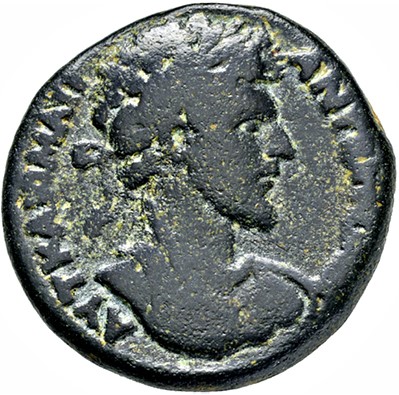
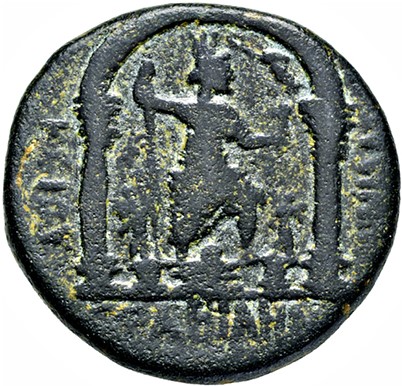
With a concentration of
victorious Tyche over water-deities minted on city-coins in
Transjordan cities, and especially in the north where the
Decapolis cities were centered, the natural question is »Why?«
What factor(s) contributed to the Transjordan cities choosing to
put a victorious Tyche over a water-deity on the reverse of
their coinage? Lichtenberger and Raja propose in the case of
Gerasa that »the citizens of Gerasa chose this type in order to
visualize the geographically favoured
position of the city directly at the Chrysorrhoas«[24].
While this could be the case, for Gerasa, it does not account
for the adoption of the image, for hilltop cities like Gadara
and Capitolias that were not directly situated on perennial
waterways.
Fresh Water
Acquisition in Coin-Minting Cities in the Southern Levant
Access to and control of
adequate supplies of fresh water have always been essential for
urban life. Along the Mediterranean littoral, mountain ranges of
the Southern Levant generate some relief rainfall as
moisture-laden clouds from the Sea, blown east by the prevailing
winds are pushed up over the heights. Porous limestone bedrock
of the hills absorbs most rainfall and produces few perennially
running waterways and no navigable rivers. Natural springs and
wells supplied people with a comparative abundance of water for
cities in Syria-Palestine as compared to Arabia. All of the
coin-minting cities in the Cisjordan, with the exception of a
few in the far southwest, surpass the 250 mm of precipitation
required for semi-arid farming. Growing populations in
coin-minting cities, however, required additional water
resources and the arduous effort of drawing water from deep
wells was supplanted by the construction of aqueducts like those
described by Roman authors Vitruvius (1st century
BCE, De Architectura [On
Architecture], Book 8) and Frontinus (ca. 35–103 CE,
Roman Aqueducts). Aqueducts of the Roman era Levant are
seen at the Cisjordanian coin-minting cities of Aelia Capitolina
(Jerusalem), Caesarea Maritima, Diospolis, Diocaesarea
(Sepphoris), Dora, Eleutheropolis, Neapolis, Nicopolis,
Nysa/Scythopolis, Sebaste (Samaria), and Tiberius[25].
Across the Jordan Rift
Valley in the East there is some relief rainfall in the heights
along the Rift but progressing eastward, as the elevation falls
it is increasingly dry and not conducive to intensive
agriculture. In the heights of Amman, Jordan (ancient
Philadelphia) the average annual rainfall is 187 mm[26].
In Jerash, Jordan (ancient Gerasa) the annual precipitation is
204 mm. In Bayt Ras, Jordan (ancient Capitolias), the average
annual rainfall is 205 mm[27].
There is little reason to believe that the overall climate of
the region today is significantly different from what it was in
the second and third century CE. Therefore, in order for the
urban centers of Arabia and Syria-Palestine to initially attain
their stature as a polis and to provide for a significant
population they had to have some natural perennial water
sources. As long as settlements were modest in size, wells,
local springs, and domestic cisterns that collected winter
rainwater from roofs and slopes were sufficient sources. When
cities like Gadara, Hippos, and Capitolias were founded on
water-poor, strategic heights and urban populations increased,
enhanced water acquisition systems were essential[28].
By the second century many Levantine cities constructed
large-scale water systems that augmented the naturally available
local water sources. Cities of the northern Transjordan often
benefitted from local water tunnels cut through the soft
limestone bedrock diverting water from nearby springs at higher
elevations. Inscriptions that identify the funders and overseers
of such large scale hydraulic projects are unfortunately rare.
The high level aqueduct at Caesarea Maritima funded by the
Emperor Hadrian c. 130 CE and constructed by detachments of
Roman legions provide such an example. That imperial funding of
an aqueduct for a loyal city, and bastion of Roman power in the
face of rising Jewish opposition to Roman rule was consistent
with Hadrian’s utilitarian benefactions. He initiated many such
benefactions to promote provincial identification with Rome in
many loyal cities around the Roman Empire[29].
The most ambitious
regional aqueduct that has been tracked in the Transjordan in
recent years is the traditionally identified Qanāt Fir’aun
(Pharaoh’s Canal). This Roman era project completed in the
mid-second century in the time of the Antonine Emperors was
supplied with water from multiple springs in the northern Nuqrah
(ancient Batanaea). They collected in a dam at Eldili, Syria and
delivered the captured water through one of the longest of all
Roman era aqueducts to a terminus at Gadara.[30]
The cities along the course of this extensive central Decapolis
water system that benefited from this particular aqueduct
include Adra’a, Dion, and Abila (Map 3). Other cities in
the Transjordan that had their own major functioning aqueducts
by the mid-third century CE include: Bostra, Caesarea
Paneas, Canatha, Capitolias, Gerasa, Hippos-Sussita, Petra, and
Philadelphia (see Table 1 for a complete list of
coin-minting cities of Transjordan that were supplied with water
from aqueducts by the third-century CE.).
|
Coin-Minting
Cities |
Aqueduct/ Number/Romaq
Identifier |
Source |
|
Abila |
Y
/ 2 / #485, 486 |
Mare 1984 |
|
Adra’a |
Y
/ - / #1137 |
Döring 2017 |
|
Bostra |
Y
/ - / #864 |
Braemer et al. 2009, 41 f.;
Kindler 1983, 20 |
|
Caesarea
Paneas |
Y
/ - / #598 |
Hartal 2002;
Wilson 2004, 53 |
|
Canatha |
Y
/ - / #1213 |
Braemer et al.
2009, 41 f.; Peuser 2000, 223–229 |
|
Capitolias |
Y |
Lenzen 1997 |
|
Charach-Moba |
|
|
|
Dion |
Y
/ - / #1196 |
Döring 2017 |
|
Ebusus |
|
|
|
Gadara |
Y
/2 / #488 |
Döring
2017; Keilholz 2017; Zenz 2006 |
|
Gerasa |
Y
/ 3 / #489 |
Boyer
Forthcoming; Lepaon 2012; Passchier et al. 2021 |
|
Hippos-Sussita[31] |
Y
/ 2 / #325, 326 |
Kowalewska – Eisenberg 2017;
Meshel et al. 1998 |
|
Madaba |
Y |
Hansons 2016, 297 |
|
Pella |
|
|
|
Petra |
Y
/ 4 / #492 |
Bellwald 2008,
61; Ortloff 2005 |
|
Philadelphia |
Y
/ - / #493 |
Hanson 2016,
771; Waheeb 1995 |
|
Philippopolis |
Y |
Hanson 2016, 298 |
|
Rabbath-Moba |
|
|
When substantial
perennial fresh water access was acquired, city officials, like
those in Rome, controlled private access and made it primarily
available to the citizenry. This was done through the
construction of various monumental water features such as
fountains, nymphaea, and thermae (i.e.,
Bathhouses). While not every coin-minting city has been
extensively excavated, studied, and the findings published,
where data is available there is a high degree of correspondence
between a city that minted coins with an image of Tyche
subjugating a water-deity and that city being able to distribute
fresh water in monumental water amenities since its Tyche had
›enabled‹ the engineers and rock-cutters to capture a water
source (see Table 2 for Transjordan coin-minting cities
that had monumental water features. See Table 3
for monumental public water features in coin-minting cities of
the Cisjordan [limited to cities with specimens of a water-deity
subjugated to a standing or sitting Tyche on a coin])[33].
|
Coin-Minting
Cities |
Nymphaeum
/ Fountains |
Thermae |
Cisterns |
Source |
|
Abila |
|
Y |
|
Smith[34];
Kowalewska 2021, 26 |
|
Adra’a |
|
Y |
|
Döring 2017; Kowalewska 2021,
35 |
|
Bostra |
Y |
Y |
Y |
Kowalewska 2021,
35 |
|
Caesarea
Paneas |
Y |
Y |
|
Kowalewska 2021,
22; Wilson 2004, 53 |
|
Canatha |
Y |
Y |
|
Kowalewska 2021,
26; Peuser 2000, 223–229 |
|
Capitolias |
|
|
Y |
Lenzen 1997, 40 |
|
Charach-Moba |
|
|
|
|
|
Dion |
|
Y |
|
Kowalewska 2021,
26 |
|
Esbus |
|
|
|
|
|
Gadara |
Y |
Y |
|
Keilholz 2017;
Kowalewska 2021, 29; Zenz 2006 |
|
Gerasa |
Y |
Y |
Y |
Boyer
Forthcoming; Kowalewska 2021, 29; Lepaon 2012; Passchier
et al. 2021 |
|
Hippos-Sussita |
Y |
Y |
|
Kowalewska 2021,
30; Kowalewska & Eisenberg 2017; Segal 2008 |
|
Madaba |
|
Y |
|
Hanson 2016, 297 |
|
Pella |
|
Y |
|
Kowalewska 2021,
32 |
|
Petra |
Y |
Y |
Y |
Kowalewska 2021,
41; Ortloff 2005 |
|
Philadelphia |
Y |
Y |
|
Hanson 2016,
771; Kowalewska 2021, 32; Waheeb 1995 |
|
Philippopolis |
|
Y |
|
Kowalewska 2021,
41 |
|
Rabbath-Moba |
|
|
|
|
|
Coin-Minting
Cities |
Nymphaeum |
Thermae |
Cisterns |
Source |
|
Antipatris |
|
|
|
|
|
Caesarea
Maritima |
Y |
Y |
|
Kowalewska 2021,
16 |
|
Eleutheropolis |
|
Y |
Y |
Kowalewska 2021,
44; Sagiv – Zissu – Amit 2002 |
|
Gaba |
|
|
|
|
|
Nysa-Scythopolis |
|
Y |
Y |
Hanson 2016,
781; Kowalewska 2021, 30 |
|
Ptolemais |
|
Y |
|
Mishnah Avodah
Zarah 3:4 |
Conclusion
The preponderance of
evidence from the Syro-Palestinian and Arabian provincial urban
centers which minted coins in the second and third centuries CE
is that cities featuring Tyche in triumph over water deities had
constructed significant water supply systems by the time when
the coins were struck. With the completion of canals and water
tunnels that led from outlaying springs and catchment basins,
citizens could draw water from public wells that opened over an
aqueduct as its waters flowed beneath the surface to a central
terminus where perpetually flowing fountains supplied citizens
with water to drink amongst architectural marvels. Nymphaea
created moist, pleasant-sounding, numinous settings and baths
really made provincial citizens or travelers feel like they were
›Romans‹. This was particularly remarkable in the arid environs
of Syria-Palestine and Arabia. Civic leaders that included the
image of Tyche standing or resting with her feet on
water-deities claimed a superior status. They believed that
their Tyche was to be worshipped, for providing plentiful water
and highlighted her being on their coins.
[1] Harl
1987.
[2] See
Howgego 2005a, 1–17; Heuchert 2005, 29–56.
[3] On
the cornucopia as an emblem of virtus, see
Gersht 2013, 207, 216–217.
[4] On
Tyche cf. e.g. Matheson 1994; Christof 2001, Meyer 2006.
Regarding Tyche in the cities of the Decapolis cf.
Lichtenberger 2003, 295–304.
[5]
Favored in the Cisjordan and rare in the Transjordan is
Tyche standing with her foot on the prow of a boat,
perhaps directing the life/course of the poleis.
Numismatists have identified such Tyche images on coins
minted by the coastal cities of Anthedon (e.g.,
RPC VI [online] temp. nos.
9150.
9151), Antipatris (e.g., RPC
VI [online] temp. nos.
8987.
8990), Ascalon (e.g., RPC
I nos.
4878A.
4878B; RPC II no.
2207), Caesarea Maritima (e.g.,
RPC IX no.
2050; RPC IV.3 [online]
temp. no.
8485), Dora (Motta 2015, no. 39), Joppa
(Rosenberger 1975, 77 no. 7), Tiberias (e.g., RPC
III nos.
3923.
3933), Tyre (e.g., Lichtenberger – Raja
2020b, 128 no. 15). Cisjordanian cities not directly
adjacent to a sea that depict Tyche on a boat include:
Neapolis (e.g., RPC IV.3 [online] temp.
nos.
3798.
6355), and Nicopolis-Emmaus (e.g.,
RPC VI [online] temp. no.
9004). In the Transjordan, Esbus (e.g.,
RPC VI [online] temp. no.
9345), Medaba (e.g., Spijkerman 1978,
182–183 nos. 5–6), and Philadelphia (e.g., Spijkerman
1978, 248 f. no. 18) are indistinct and have been
alleged to depict an image of Tyche on a boat but the
object under Tyche’s foot is not certain. Given that
there was shipping on the Dead Sea and the Jordan was
navigable (cf. Strab. 16.2.16; Hirschfeld and Ariel
2005) Tyche standing on a prow may not be that out of
place for Transjordan cities near the Dead Sea.
[6]
Artemis-Tyche is depicted with a bow and quiver on the
coins of Gerasa (see Spijkerman 1978, 158–165 nos. 4. 5.
8. 14. 18. 19. 24. 26. 27).
[7]
Athena-Tyche is seen with armor on coins of Bostra (see
Spijkerman 1978, 70–75 nos. 8. 22. 26).
[8]
Bowsher 1987, 66. See also the discussion in Wenning
1986, 123 f. and Meyer 2006, 251–278.
[9] The
Spijkerman (1978) collection includes busts of Tyche
only on the obverse of seven total quasi-autonomous coin
issues including those from Bostra (68 nos. 3. 4),
Gadara (128 nos. 3–7), and Gerasa (158 no. 2).
[10] The
Spijkerman (1978) collection includes busts of Tyche on
the reverse of (fifty-six total) coins from Abila 2. 7.
8; Adraa 4. 5; Bostra 7. 16–21. 25. 29. 45–47. 54. 58.
65; Canatha 1. 3–5, Charach-Moba 4; Gadara 3–7. 9. 11.
14. 16. 19. 24. 27. 29; Nysa Scythopolis 8. 9. 11. Petra
7–9. 16. 21. 25; Philadelphia 10. 16. 25. 31. 33. 38.
39; Rabbath-Moba 22. 23. 40.
[11]
Paus. 6.2.7
[12]
Meyer 2022, 24 remarks that not only is Tyche
subjugating Orontes, the only year around water bearing
river in the region, but by sitting on a rock she also
controls the local mount Silpios.
[13] cf.
Baukova 2021.
[14]
Spijkerman (1978), Adraa (60–63 nos. 6. 11. 14).
See also Lichtenberger 2019, 4 f.
[15] Hes. theog.
337–370. Among the lesser
younger deities of the Oceanid family line there were a
variety of Nymphs. Among these were the Naiads
– fresh water gods who presided over fresh water
supplies of the earth, such as springs, rivers, lakes,
fountains and marshes. They are classified into five
sub-groups, known as Pegaeae (springs),
Potameides (rivers), Limnades (lakes),
Crinaeae (fountains), and Eleionomae
(marshes).
[16]
Butcher 2003. One of the first cities to use the image
of Tyche subjugating a water deity was Damascus, during
the reign of Demetrius III (95–84 BCE), see BMC Galatia,
Cappodocia, and Syria p. 289 no. 1. The Nabatean ruler
Aretas III (c. 84–71 BCE) likewise utilized the image of
Tyche subjugating a water deity, see Meshorer 1975, nos.
5–6.
[17]
Howgego 2005b, 146.
[18]
Abila (e.g., Spijkerman 1978, 50 f. no. 1), Adraa (e.g.,
Spijkerman 1978, 62 f. no. 14), Bostra (e.g., Spijkerman
1978, 68 f. nos. 5–6), Canatha (e.g., Spijkerman 1978,
94 f. no. 10), Capitolias (e.g., Spijkerman 1978, 100 f.
nos. 7–9), Dion (e.g., Spijkerman 1978, 118 f. nos.
4–5), Gadara (e.g., Spijkerman 1978, 138 f. nos. 42–43.
45), Gerasa (e.g., Spijkerman 1978, 160 f. nos. 9–12),
Madaba (e.g., Spijkerman 1978, 184 f. no. 10), and
Rabbath-Moba (e.g., Spijkerman 1978, 266 f. nos. 14–17).
The coin references in this note and notes 20 and 22 are
representative and not an exhaustive list of specimens.
[19]
Spijkerman 1978, 70 f. no. 11.
[20]
Eleutheropolis (e.g., RPC VI [online] temp.
nos.
9131.
9132), Gaba (e.g., RPC
IV.3 [online] temp. nos.
4130.
4132.
4133), and Nysa-Scythopolis (e.g.,
Spijkerman 1978, 190 f. no. 10). (Antipatris [RPC
VI [online] temp. no.
8987] and Caesarea Maritima [RPC
III no.
3954] depict a water-deity below Tyche,
but without her foot on them).
[21]
Spijkerman 1978, 190 f. no. 10.
[22]
Canatha (e.g., Spijkerman 1978, 94 f. no. 15), Gadara
(e.g., RPC VI [online] temporary no.
9265), Gerasa (e.g., Spijkerman 1978,
160 f. nos. 11–12), Paneas (e.g., RPC VI
[online] temp. no.
9182), Pella (e.g., Spijkerman 1978,
212 f. nos. 5,7). Ptolemais is the only city west of the
Jordan River that combined a seated Tyche with a foot on
a water-deity (e.g., RPC III nos.
3911.
3911A).
[23] See
Spijkerman 1978, Abila (50–57 nos. 1. 26. 29), Canatha
(95 no. 15), Dion (118–121 nos. 4. 5. 13), Gadara
(138–148 nos. 42. 43. 45. 50. 65. 71), Nysa-Scythopolis
(203 no. 49).
[24]
Lichtenberger – Raja 2020a, 165.
[25] See
Amit – Patrich – Hirschfeld 2002.
[28] At
Gadara and Hippos siphons had to be employed to get
water from superior elevations up to the sites. In
Capitolias an extensive local water catchment system
helped to fill the largest municipal cistern in the
region. See Lucke – Schmidt – Al-Saal – Bäumier 2008,
229.
[29]
Boatwright 2017, 108.
[30]
Döring 2009; Döring 2012; Döring 2017.
[31] The
case of Hippos’ subjugation to Tyche will be discussed
in a forthcoming article by the authors.
[32] The
case of Hippos’ subjugation to Tyche will be discussed
in a forthcoming article by the authors.
[33]
Meyer 2022 makes an argument that the imagery of the
river deity crawling as if emerging from the water and
hair hanging down as if dripping wet suggests an image
of flowing water.
[34]
Smith 2018 reports the presence of a Late Roman bath
house based on the presence of slab tubulae,
round pilae fragments, and an argillite-lined
pool beneath later Byzantine ecclesiastical structures
of Area E Pilgrimage Complex. A map showing the pool of
the baths can be seen in Smith 2022, 6.
